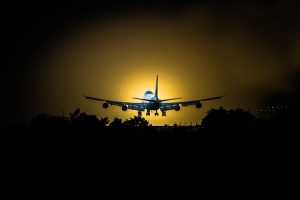
Airplanes are equipped with a variety of lights. In addition to anti-collision lights, there are landing lights. From small private jets to large commercial airliners, they are found on most airplanes. Here’s everything you need to know about landing lights.
What Are Landing Lights?
Landing lights are exactly what they sound like: lights used during landings. They are designed to help pilots see and be seen, thereby reducing the risk of accidents.
When illuminated, landing lights will improve visibility so that pilots can see more easily at night and in poor weather conditions. They will also make it easier for other pilots, ground crews and air traffic controllers to see the airplane.
What Color Are Landing Lights?
Landing lights are typically bright white. This is in contrast to navigation lights, which are usually red, green and white. Navigation lights on the left wing are red, green on the right wing and white on the tail assembly. With their color variations, navigation lights make it easy to identify the direction in which airplanes are flying.
Landing lights aren’t used for navigational purposes. Rather, they are used to improve visibility when landing. Therefore, most landing lights are bright white and located at the front of airplanes. They typically point downward at a slight angle, allowing for proper illumination of runways.
Are Landing Lights Required?
You might be surprised to learn that the U.S. Federal Aviation Administration (FAA) doesn’t require landing lights on all airplanes. Rather, they are only required for night flights involving airplanes flown under instrument flight rules. Nonetheless, most commercial airlines have their own policies requiring the use of landing lights when flying at night and in poor weather conditions.
What Type of Lighting Technology Do Landing Lights Use?
While they are all used for the same purpose — to improve landing visibility — landing lights are available in different technologies. In the past, most landing lights consisted of halogen or incandescent bulbs. You can still find airplanes that use these lighting technologies for their landing lights, but many airplanes now use light-emitting diode (LED) or high-intensity discharge (HID) technology for their landing lights.
LED and HID landing lights are brighter and more energy efficient. LED landing lights, in fact, can last for up to 20,000 hours. With their long lifespan and energy-efficient properties, they’ve become a popular alternative to older landing lights powered by incandescent or halogen technologies.



